GERMANS STRIKE BACK On December 2, when the 36th Division entered Selestat, the enemy’s situation in the Alsace Plain was critical. The Germans had been hemmed into a pocket with only two bridges remaining across the Rhine by which to withdraw (click here to view map). South of the 36th Division there were still German forces facing the II French Corps in the Vosges mountains. All intelligence indicated that the Germans were making desperate efforts to get as much as they could back to the east bank of the Rhine.
NO LETUP Turning of the VI Corps to the north took pressure off the Germans in the Colmar pocket. The disposition of the First French Army was such that, before an offensive could be resumed, a shifting of forces was necessary. The Commanding General of the II French Corps, General de Goisiard de Montsabert, thought this might be accomplished in time for the attack to begin again on the 6th. The plan called for the 36th to attack east from the vicinity of Ribeauville toward Neuf-Brisach while the 2nd French Armored drove south for the same objective. This involved a crossing of the Ill River for the 36th. Before that could be done the entire area between the Ill and the slope of the Vosges had to be cleared as far south as Kaysersberg. For the Division, therefore, there was no letup in offensive operations. The 142nd, after securing Selestat, began aggressive patrolling for Ill River crossing sites while its 2nd Battalion pushed from Koenigsbourg down the mountain trail to take St. Hippolyte and Bergheim. The 143rd had the hardest task, in clearing the St. Marie-Ribeauville road and the area on both sides of it. The terrain was extremely rugged and heavily wooded. Road blocks of huge felled trees had been placed in every defile through which the road passed. Over 1,500 yards of this abatis, mined and defended, had to be cleared. Fighting day and night Lt. Col. Theodore H. Andrews’ 3rd Battalion and a large detachment of the Company C, 111th Engineers, forced their way into the open and captured Ribeauville by the 4th. On the right of the 3rd Battalion, Lt. Col. David M. Frazior’s 1st Battalion went cross-country to isolate and clear out pockets of the enemy. MINEFIELDS HINDER ADVANCE
On December 5, the 5th Combat Command of the 4th French Armored Division and five tabors of Moroccan Goums, under the command of Brigadier General Guy Schlesser, were attached to the Division. This force moved into the Aubure area, east of St. Marie, and relieved the 141st Infantry which was then moved north to the area occupied by the rest of the Division. On December 6 the Division front line ran from Selestat on the north to Guemar and Ostheim, thence to Mittelwihr and to Hill 351 south of Riquewihr, a front 20 kilometers long, flanked on the right by an open stretch covered only by the 36th Reconnaissance Troop. After all the preliminaries had been completed, it was the weather that defeated the planned attack. Winter rains caused the III to flood its banks, the entire Alsace Plain becoming a vast swampland. Crossing the river was out of the question—nothing could move off the roads in the valley. Furthermore, the movement of French troops from the south had been slower than anticipated. The Corps commander therefore decided to postpone the attack until December 15 and swing the main effort to the 36th Division right with a view of attacking Colmar from the west. From the 2nd of December to the 6th the only pressure on the Germans had been exerted by the 36th. Their debouchment out of Ribeauville and seizure of the vineyard-covered hills overlooking Colmar so alarmed the Germans that they began moving considerable forces to oppose the Division. On December 7 they began countermeasures particularly against the center and right of the line. Stiff fights occurred at Guemar, Bennwihr and Hill 351. The 2nd Battalion, 141st, was moved in on the right of the 143rd. More German attacks followed the next day but were driven off. Enemy artillery fire increased in intensity each day, striking at every town in the Division area. Ribeauville, the Division CP, was regularly plastered by 380mm shells thrown from the far side of the Rhine. It was apparent that the Germans had stopped their withdrawal and were determined to hold Colmar. In light of the mounting German opposition and will to attack, the Division situation was not good. It was over extended and deployed with the Vosges Mountains at its back—only two precarious mountain roads traversed this obstacle. Its position lacked depth. To improve this, particularly on the open right flank, the 141st was given the mission of taking Kientzheim and Sigolsheim. The attack started off well, Company B capturing Hill 351, which had been lost the day before, and the leading platoons of Company A getting a foothold in Sigolsheim. The 2nd Battalion, however, could not get into Kientzheim. A tragic mistake by our own Tank Destroyers who fired into Company B from the rear forced them off Hill 351, leaving the two platoons of Company A cut off in Sigolsheim. All day on the 10th the fight raged. Hill 351 was retaken but the detachment of Company A was lost. Fatigued to exhaustion by its continued struggle, the Division nevertheless had practically no reserves. The 2nd Battalion, 143rd, had been assembled in Ribeauville and the 3rd Battalion, 142nd, was in Bergheim and St. Hippolyte. All other elements were in contact with the enemy and large stretches of the front were covered only by patrols. DEFENSE OF SELESTAT
But the battle at Selestat was not a local or isolated attack. It was only a part of the onslaught which hit the entire division on that date. Shortly after daylight a full. scale attack was launched in the center against Mittelwihr and up the draw behind nearby Hill 251. This attack struck the 1st Battalion, 143rd Infantry and the 1st Battalion, 141st Infantry. The German main effort, however, was directed at the Division right flank. Here a large force, the entire student body of an officer candidate school, at least 100 strong, attempted to envelop the Division flank and reach the Ribeauville-St. Marie road. Had they succeeded in this the 36th Division would possibly have been destroyed. CRISIS AT RIQUEWIHR
Enemy artillery, increasing toward noon, laid counter battery fire heavily onto several of the artillery battalions. Along the entire front friendly chemical mortars, tanks, tank destroyers and artillery fired furiously. By midafternoon the attacks had been repulsed all along the front. To the right of the Division, however, several groups of Germans did succeed in getting as far back as the artillery positions. One piece in the 133rd Field Artillery Battalion was blown up but the attempted raid was beaten off by the prompt and effective work of attached gunners of the 443rd Anti-Aircraft Battalion who turned their flak wagons loose on the attackers. The slaughter of Germans, in places covering the vineyards in the center and right flank of the Division, was very great. Next day the enemy attacks were resumed but with less vigor and no success. December 14 saw the end of the German effort. The enemy plan to break through the 36th had been frustrated, and a terrific casualty toll inflicted upon them. Prisoner identifications showed that at least 6,800 infantry had been brought across the Rhine for this effort. Prisoners taken by the Division during this period, December 6-14, totaled 1,360. FOR THE FATHERLAND
|

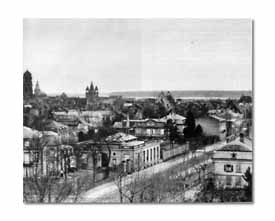
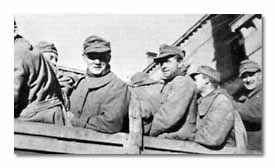
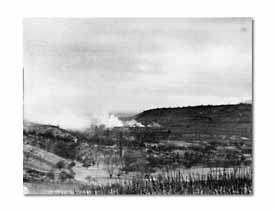
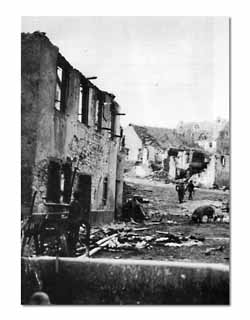
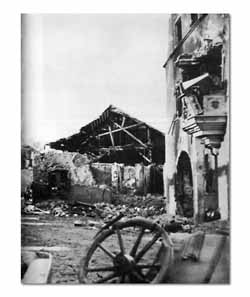
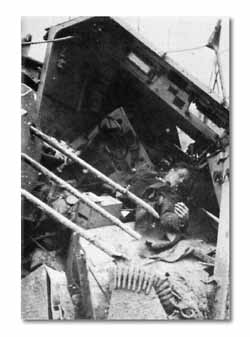
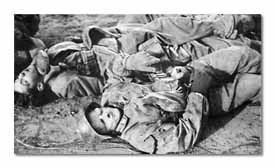
 WINNERS: PFC.
GERALD GORDON, with the medics attached to the 143rd, in the heat of the German attack at
Mittelwihr, ripped off the red-cross arm band, grabbed a rifle and tore the German line
apart when he saw that the krauts were about to overrun his company. Reported missing in
action, Gordon was found at the end of the war in a hospital in England. His home is in
St. Joseph, Missouri.
WINNERS: PFC.
GERALD GORDON, with the medics attached to the 143rd, in the heat of the German attack at
Mittelwihr, ripped off the red-cross arm band, grabbed a rifle and tore the German line
apart when he saw that the krauts were about to overrun his company. Reported missing in
action, Gordon was found at the end of the war in a hospital in England. His home is in
St. Joseph, Missouri.  T/SGT. BERNARD BELL, platoon leader of "I" Co.,
142nd. Holed-up in a wrecked schoolhouse with five of his men, Bell held out against
repeated enemy infantry-with-armor attacks at Mittelwihr. His action in defense of a key
position helped stem the German advance. President Truman awarded Bell the CMH in a
special ceremony on the White House lawn.
T/SGT. BERNARD BELL, platoon leader of "I" Co.,
142nd. Holed-up in a wrecked schoolhouse with five of his men, Bell held out against
repeated enemy infantry-with-armor attacks at Mittelwihr. His action in defense of a key
position helped stem the German advance. President Truman awarded Bell the CMH in a
special ceremony on the White House lawn.